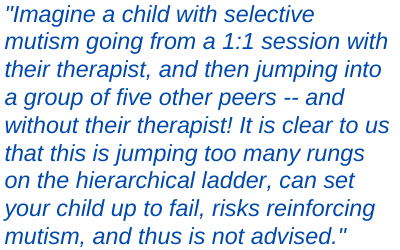Anxiety Group Therapy
ATSA's Unique Approach to Group Therapy for Selective Mutism and Social Anxiety
As with Adventure Camp Intensive Treatment for Selective Mutism, children with selective mutism or a history of selective mutism cannot start a group de novo. That is, children cannot start a group 1.) without an evaluation and 2.) without completing a peer exposure successfully. If these measures are not taken, then we risk the chance that your child will be mute in group, inadvertently reinforcing their mutism, which of course we strive to avoid.
For Adventure Camp, we use lead-in sessions to expose your child to Counselor 1, then Counselor 2, and then to a Counselor/Camper dyad for a peer exposure. If your child can successfully respond to their counselor, we deem your child ready for the Adventure Camp's intensive group treatment. At camp, we continue working on goals, including interacting in front of and with other adults and peers.
For outpatient groups at ATSA, we similar, but higher, level of criteria. Even if your child is comfortably speaking and interacting with their ATSA therapist, we know from experience that this does not mean they are ready to participate in a group. We know from experience that changing just one variable (e.g., adding one peer) can alter your child’s behavior (e.g., speaking); we need time to habituate your child to speaking in front of more than just one person, which is not practical to do during an outpatient group. Imagine a child with selective mutism going from a 1:1 session with their therapist, and then jumping into a group of five other peers - and without their therapist! It is clear to us that this is jumping too many rungs on the hierarchical ladder, can set your child up to fail, risks reinforcing mutism, and thus is not advised. Consistent with exposure therapy principles, it behooves everyone concerned to move systematically through the successive steps of exposures to ensure that your child is ready for group therapy.
At Adventure Camp group therapy, we have 1:1 Counselor to Camper ratio, so we have the resources prepared to help each child where they are in their hierarchy of exposure for the intensive 5-day treatment. The expectation is that your child can consistently respond to their Counselor in front of others. From there, we branch out. When participating in non-intensive outpatient therapy groups at ATS, it is assumed that your child has reached the rung on their hierarchical ladder to be able to participate in group without the 1:1 intensive assistance that is provided in Adventure Camp.
ATSA's non-intensive outpatient groups continue to employ the principles of exposure that allow your child to move through the graduated steps of an exposure hierarchy within a group format. There are various group levels; each group level corresponds to a rung on the hierarchal ladder. Group levels range from entry level group exposures to more advanced group exposures. Each group level has been tailored to meet the exposure needs of children in early, mid, or later stages of treatment.
We have examined different methods for preparing children for groups and have since established what we believe to be a conservative, thought-out hierarchical approach to group therapy. We have established criteria for group eligibility for each group’s level on the group hierarchical ladder. Please click on the pages to the right to read the brief descriptors and learn more about the group’s expectations and corresponding prerequisites.

ATSA's Hierarchical Approach
Level 1
Lunch Bunch (adapted for Level 1)
Level 2
Level 3
Level 4
Level 5